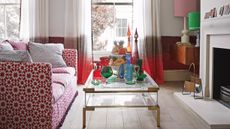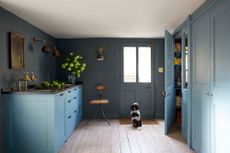Russell Sage shares the art of getting flooring right in your home
When you choose a floor, you’re making a long-term commitment. After all, it’s easy to change some elements of a room, but an upheaval – not to mention expensive – to alter the floor.
That’s why it’s important to consider flooring at the start of a project. So we've turned to Russell Sage – the interior designer behind Zetter Townhouse, The Conduit and Kittyhawk, to name but a few – about his approach.
With varied projects covering high-traffic areas like hotel lobbies and bars, as well as private bedrooms and sitting rooms that put comfort first, Russell knows the difference good flooring can make.
Here, he explains how to wow, looks for now, and the practical considerations to make when picking a floor.

1. Keep it classic
Sometimes it pays not to be too fashionable. The floor you choose could be in your home for 20 years – perhaps more. So it can be sensible to opt for a material with longevity rather than something that’s on trend.
When you’re thinking through your flooring options, consider how much maintenance you’re able (and likely) to do. This is always a huge part of my decision-making process. Also think about how you live and who you live with. For example, if you have young children, a white carpet isn’t going to be practical.
Don’t forget to think long term either. A bump-proof, easy-to-clean floor is perfect when you have small children, but what about when they grow up and move out, and you want something more sophisticated? Think about the history of your home, too. A marble floor in a Victorian house, for example, is just not going to chime well.

2. Do your prep
If you’re updating an existing floor, start by finding out what the floor build-up is and what this means you can put on top. If it’s a wooden floor on joists, you’re not going to be able to lay marble without strengthening the build-up. Begin by working out what you’re working with – then you can explore your options.

3. Get creative
I like to play with materials – for example, laying thick rugs onto bare floorboards. If you’ve got more of a contemporary space, you can mix finishes too. Half the room could be floorboards and the other half could be something else. You can use flooring to make a small room look bigger too. Keep the floor light and match it to the colour of the skirting boards or the doors: this will expand the space.

4. Know your materials
When it comes to bedrooms, I prefer carpet because it has a softening effect. In bathrooms, I’ve done great things with wood-effect porcelain. By matching it to floorboards outside the bathroom, the floor can run seamlessly throughout the house, extending the space.
A word of warning: if you’ve installed central heating in an old house, don’t turn it on full blast suddenly. Floorboards might crack or gaps may appear. Instead, turn it up slowly over two to three weeks. This is the case for engineered wood, too.

5. Add cash
Quality flooring that’s installed properly will likely add value to your property. Conversely, if you cut corners, it’s likely to devalue your property. As with other property-related decisions, it’s wise to dedicate a sensible amount of your budget to making sure your property is protected in the future.

Words / Sophie Baylis
Be The First To Know
The Livingetc newsletter is your shortcut to the now and the next in home design. Subscribe today to receive a stunning free 200-page book of the best homes from around the world.
The homes media brand for early adopters, Livingetc shines a spotlight on the now and the next in design, obsessively covering interior trends, color advice, stylish homeware and modern homes. Celebrating the intersection between fashion and interiors. it's the brand that makes and breaks trends and it draws on its network on leading international luminaries to bring you the very best insight and ideas.
-
 The 12 Best Table Lamps for Reading —I'm a Certified Bookworm (and Shopping Expert)
The 12 Best Table Lamps for Reading —I'm a Certified Bookworm (and Shopping Expert)When it comes to table lamps for reading, I don't mess around. If you're the same, this edit is for YOU (and your books, or course — and good recommendations?)
By Brigid Kennedy Published
-
 "It's Scandi Meets Californian-Cool" — The New Anthro Collab With Katie Hodges Hits Just the Right Style Note
"It's Scandi Meets Californian-Cool" — The New Anthro Collab With Katie Hodges Hits Just the Right Style NoteThe LA-based interior designer merges coastal cool with Scandinavian simplicity for a delightfully lived-in collection of elevated home furnishings
By Julia Demer Published
-
 Florist Angela Maynard on how to care for dried flowers and how to style them in a modern home
Florist Angela Maynard on how to care for dried flowers and how to style them in a modern homeKnowing how to care for dried flowers means you can have stylish arrangements that last for years. Author and florist Angela Maynard shares her tips
By Angela Maynard Last updated
-
 11 beige living room ideas that prove beige can be far from boring
11 beige living room ideas that prove beige can be far from boringBeige living room ideas might sound not sound like the boldest of color schemes but this pared-back palette can be just as striking a brights
By Amy Moorea Wong Last updated
-
 How to use color in small living rooms – expert tips for getting the perfect scheme
How to use color in small living rooms – expert tips for getting the perfect schemeBringing color into small living rooms can be tricky, but with the right hues and our top tips, you can make the space look brighter, bigger and just better
By katesleeman Published
-
 How to choose cool colour combinations for your home
How to choose cool colour combinations for your homeThe right colour combinations will look good throughout your home. Dagny Thurmann-Moe of Koi Colour Studio shares the no-go palette pairings and power hues
By Livingetc Published
-
 Buying a used kitchen could be your savviest design idea - here's what you need to know
Buying a used kitchen could be your savviest design idea - here's what you need to knowBuying an ex-display used kitchen is a way to a high-end home at High Street prices
By Jacky Parker Published
-
 Home decorating: Tricia Guild's guide to a confident scheme
Home decorating: Tricia Guild's guide to a confident schemeHome decorating advice from legendary designer Tricia Guild OBE
By Livingetc Published
-
 How to achieve beautiful paint finishes according to interior designer, Nicola Harding
How to achieve beautiful paint finishes according to interior designer, Nicola HardingBeautiful paint finishes transform a room and are easier than you think
By Livingetc Last updated
-
 The meaning of style, by interior designer Russell Sage
The meaning of style, by interior designer Russell SageAcclaimed interior designer Russell Sage talks broken rules, secret ingredients and looking good in any light
By Russell Sage Published









